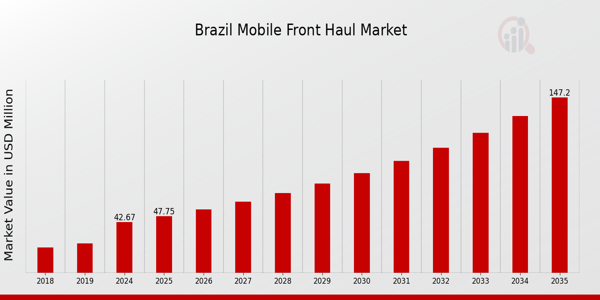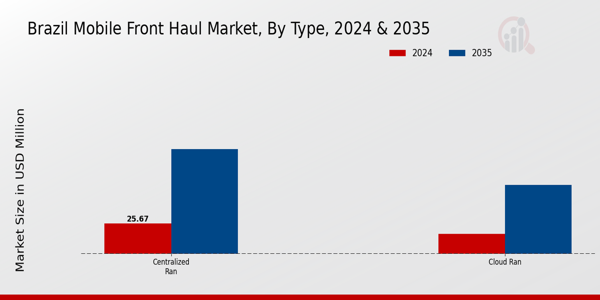Brazil Mobile Front Haul Market Overview
As per MRFR analysis, the Brazil Mobile Front Haul Market Size was estimated at 37.36 (USD Million) in 2023.The Brazil Mobile Front Haul Market is expected to grow from 42.67(USD Million) in 2024 to 147.2 (USD Million) by 2035. The Brazil Mobile Front Haul Market CAGR (growth rate) is expected to be around 11.915% during the forecast period (2025 - 2035).
Key Brazil Mobile Front Haul Market Trends Highlighted
The Brazil Mobile Front Haul Market is experiencing significant growth driven by the demand for high-speed mobile data and the deployment of 5G technology across the country. One of the key market drivers is the Brazilian government's push to enhance telecommunications infrastructure, which is evident through initiatives like the National Broadband Plan that aims to improve connectivity in urban and rural areas. As mobile operators strive to meet the rising data consumption generated by mobile applications, video streaming, and IoT devices, there is a pressing need for advanced front haul solutions that offer low latency and high capacity.
Opportunities in the market are being captured by technology providers who are introducing innovative optical and transport solutions tailored to the Brazilian context.The growing investment in fiber optic networks is creating a good environment for the mobile front haul segment. Also, as Brazilian cities work on becoming "smart cities," they need a reliable and efficient mobile communications infrastructure to support a wide range of applications, from smart traffic management to connected public services.
Telecommunications companies have been moving toward virtualization and cloud-based solutions lately. These solutions help operators save money and make their networks more flexible. Brazilian telecom companies are looking into these options to make their networks even better.
The growing interest in edge computing also aligns with the needs of mobile front haul, as it helps bring data processing closer to end-users, decreasing latency and improving performance. All these factors underline the dynamic landscape of the Brazil Mobile Front Haul Market and highlight how the combination of regulatory support, technological innovation, and changing consumer expectations continues to shape industry trends in the region.

Source: Primary Research, Secondary Research, Market Research Future Database and Analyst Review
Brazil Mobile Front Haul Market Drivers
Increase in Mobile Data Consumption
In Brazil, the demand for mobile data is surging as a result of the increased use of smartphones and mobile applications. According to data from the Brazilian National Telecommunications Agency (ANATEL), the country witnessed a 23% year-on-year increase in mobile data consumption in 2022, driven largely by the rise in video streaming services and social media usage.
As users demand more data, telecommunications providers are investing in the Mobile Front Haul Market to enhance their infrastructure, making it a crucial driver for the Brazil Mobile Front Haul Market.With major companies like Vivo and Claro expanding their networks to accommodate this growth, the need for efficient mobile front haul solutions becomes essential to prevent bottlenecks and ensure high-quality service delivery.
Government Initiatives for 5G Deployment
The Brazilian government has made substantial investments and strategic plans to accelerate the rollout of 5G technology across the nation. The Ministry of Communications (Minicom) outlined a comprehensive strategy aiming to cover 60% of the Brazilian population with 5G networks by 2025. This initiative not only enhances mobile connectivity but also promotes the development of the Mobile Front Haul Market in Brazil.
Companies like TIM Brasil are already initiating partnerships to develop 5G infrastructure, thereby increasing demand for mobile front haul solutions to support the high-speed networks.As Brazil continues to embrace digital transformation, this government push is a significant driver for growth in the Brazil Mobile Front Haul Market.
Adoption of Cloud-based Services
The shift towards cloud-based services is rapidly transforming the telecommunications landscape in Brazil. According to an industry report by the Brazilian Association of Telecommunications Companies (Telebrasil), 70% of telecom operators in the country are likely to adopt cloud-based solutions to optimize their operations by 2025.
This trend drives the need for advanced mobile front haul technologies that can seamlessly integrate with cloud infrastructures.Leading companies, including Oi and Nextel, are already investing in cloud solutions to cope with vast data traffic, proving that the transition to the cloud is a vital contributor to the growth of the Brazil Mobile Front Haul Market.
Rising Urbanization and Smart City Initiatives
As Brazil becomes increasingly urbanized, with projections indicating that 90% of the population will live in urban areas by 2030, there is a growing demand for advanced telecommunications infrastructure. The Brazilian government has implemented several Smart City initiatives to improve urban living with technologies that require robust mobile connectivity.
Municipal programs in cities like São Paulo and Rio de Janeiro focus on deploying smart traffic lights, public safety systems, and environmental monitoring of which depend on reliable mobile front haul technologies.This urban expansion and commitment to innovation significantly boost the Brazil Mobile Front Haul Market.
Brazil Mobile Front Haul Market Segment Insights
Mobile Front Haul Market Type Insights
The Brazil Mobile Front Haul Market is increasingly characterized by innovations and enhancements across various segments, prominently including types like Cloud RAN and Centralized RAN. Cloud RAN, which utilizes cloud computing technology to consolidate baseband processing functions at a central location, allows operators to efficiently scale their network capabilities while reducing operational costs. This segment significantly enhances network flexibility and can lead to improved service delivery.
As Brazil continues to undergo digital transformation initiatives, the Cloud RAN segment’s adaptability makes it a critical driver in the push for high-capacity and efficient mobile networks. On the other hand, Centralized RAN focuses on centralizing radio resources to manage multiple base stations, thereby optimizing performance and providing better coverage, which is vital for urban areas in Brazil where high-density user demands are observed.
This segment reduces latency and improves overall network quality, catering well to the demands of an increasingly connected population in Brazil. In Brazil, growing smartphone penetration and a surge in data consumption position both Cloud RAN and Centralized RAN as beating hearts of modernization within telecommunications infrastructure. The Brazilian government has initiated numerous projects aimed at enhancing telecommunication services across the nation, highlighting the importance of these RAN types in the future roadmap of telecommunications.
The focus on Cloud RAN aligns with broader trends toward cloud-based services, demonstrating a shift in how telecom operators are approaching network management. Meanwhile, Centralized RAN is becoming increasingly important with the rollout of next-generation connectivity options like 5G, as it supports the high performance and low latency that modern applications demand. As Brazil navigates challenges like existing infrastructure limitations and varying geographic demands, these types of Mobile Front Haul frameworks will play increasingly significant roles in overcoming such hurdles.
With a better understanding of network functionality through these advanced types, operators can leverage opportunities for investment in emerging technologies, while also staying agile in the face of competitive pressures in the telecommunications sector. As market dynamics evolve within Brazil’s Mobile Front Haul Market, the ongoing development and deployment of Cloud RAN and Centralized RAN will be critical in shaping the future landscape of telecommunications in the region.

Source: Primary Research, Secondary Research, Market Research Future Database and Analyst Review
Mobile Front Haul Market Service Insights
The Service segment of the Brazil Mobile Front Haul Market plays a pivotal role in ensuring effective communication and data transfer within the telecommunications sector. This segment is characterized by its two main components: Professional Services and Managed Services, each contributing uniquely to the industry. Professional Services include consulting and implementation, which help in optimizing network performance and enhancing operational efficiency.
Managed Services offer ongoing maintenance and support, providing flexibility and scalability to telecom providers as they adapt to rapidly evolving technologies.The growth of mobile data traffic and the push for advanced network solutions are significant factors driving demand in this segment.
Concurrently, the increase in investments towards infrastructure development and the adoption of next-generation technologies are further propelling Service segment growth. Given Brazil's diverse geography and varying customer needs, the demand for customizable and robust Service solutions is particularly notable, allowing providers to improve user experience and drive customer satisfaction. With ongoing advancements and a growing emphasis on digital transformation, this segment is poised for substantial growth, reflecting the broader trends in Brazil's mobile telecommunications landscape.
Mobile Front Haul Market Network Insights
The Brazil Mobile Front Haul Market’s Network segment plays a critical role in advancing telecommunications infrastructure across the nation. With the rapid adoption of mobile technologies, this segment has seen significant growth, driven by increasing demand for high-speed data and connectivity. Passive Wavelength Division Multiplexing (WDM) is crucial as it offers efficient bandwidth utilization, primarily serving to expand network capacity without the need for costly upgrades. Ethernet solutions further enhance network performance, providing cost-effective and scalable connectivity essential for meeting the rising user demands.
Active WDM is vital for high-capacity transmission, enabling service providers to support emerging applications and services. The Brazil Mobile Front Haul Market is characterized by continuous technological advancements, with opportunities for enhancing network reliability and efficiency. Key growth drivers include the expansion of 5G networks and government initiatives aimed at promoting digital inclusion. Challenges such as infrastructure costs and the need for skilled workforce remain prevalent. Nevertheless, the overall market growth reflects a promising trend toward robust and efficient mobile communication systems, supporting Brazil's digital transformation journey.
Brazil Mobile Front Haul Market Key Players and Competitive Insights
The Brazil Mobile Front Haul Market is experiencing dynamic shifts due to the increasing demand for high-speed mobile connectivity and the ongoing evolution of telecommunications technologies. Competitive insights reveal a landscape where telecommunication service providers, infrastructure developers, and technology innovators engage to enhance their offerings, drive down latency, and improve network reliability. Factors such as the rollout of 5G technology and the necessity for efficient data transport solutions are central to the competition in this market.
Companies are focusing on developing advanced architectures and cost-effective solutions to facilitate seamless connectivity and meet the advancing requirements of mobile operators, thereby transforming both urban and rural areas' access to mobile services.
TIM has established a substantial presence in the Brazil Mobile Front Haul Market, leveraging its extensive network infrastructure and innovative technologies. The company showcases strengths in its ability to optimize network performance while ensuring reliability and flexibility. TIM's strategic initiatives include enhancing backhaul capabilities, resulting in improved end-user experiences across various mobile applications. The company is also committed to expanding its fiber optic reach, which not only aids in the front haul segment but also supports broader network connectivity.
TIM's strong brand recognition and trust among consumers, along with its ability to respond swiftly to market demands, position it favorably within this competitive landscape.
Ciena plays a pivotal role in the Brazil Mobile Front Haul Market through its advanced networking solutions that cater to mobile operators' evolving needs. Known for its focus on intelligent networking, Ciena provides key products and services, such as packet-optical transport and network automation technologies. Their solutions emphasize scalability, enabling operators to manage increasing data traffic while maintaining high performance. In Brazil, Ciena has emphasized partnerships with local telecommunications companies, which have bolstered its market presence and contributed to various successful integrations and deployments.
The company has also pursued mergers and acquisitions to strengthen its product portfolio and expand its capabilities, further solidifying its position as a key player in enhancing mobile front haul operations within the region. Through these efforts, Ciena continues to address the challenges of modern mobile networks, ensuring efficient and effective service delivery across Brazil’s diverse economic landscape.
Key Companies in the Brazil Mobile Front Haul Market Include:
- TIM
- Ciena
- Cisco
- KAROO Networks
- Juniper Networks
- Oi
- ZTE
- Telefonica
- Vivo
- Nokia
- Huawei
- Samsung
- Ericsson
- AT&T
- Claro
Brazil Mobile Front Haul Market Developments
In the Brazil Mobile Front Haul Market, recent developments have showcased significant advancements and partnerships among key players. TIM has been focusing on expanding its network with innovative solutions in collaboration with Nokia and Huawei to improve mobile connectivity, particularly in underserved regions. Ciena and Cisco are also making strides by enhancing optical transport networks, adapting to the growing demand for higher bandwidth and lower latency requirements, attributable to an increase in mobile data consumption in Brazil.
In December 2022, Oi announced collaborations with ZTE and Ericsson for infrastructure upgrades, aiming to ease the transition to 5G networks. Moreover, growth in the mobile sector has led major telecom companies like Vivo and Claro to invest heavily in backhaul and fronthaul systems, which are crucial for efficient data transfer in their networks.
The market is witnessing heightened competition, with Samsung and Juniper Networks actively participating through solutions that offer scalability and flexibility. Recent government initiatives in Brazil to bolster digital transformation have further propelled demand, supporting the expansion of optical networks and sustainable technologies integral to the Mobile Front Haul Market.
Brazil Mobile Front Haul Market Segmentation Insights
Mobile Front Haul Market Type Outlook
-
- Cloud RAN
- Centralized RAN
Mobile Front Haul Market Service Outlook
Mobile Front Haul Market Network Outlook
-
- Passive WDM
- Ethernet
- Active WDM
| Report Attribute/Metric Source: |
Details |
| MARKET SIZE 2023 |
37.36(USD Million) |
| MARKET SIZE 2024 |
42.67(USD Million) |
| MARKET SIZE 2035 |
147.2(USD Million) |
| COMPOUND ANNUAL GROWTH RATE (CAGR) |
11.915% (2025 - 2035) |
| REPORT COVERAGE |
Revenue Forecast, Competitive Landscape, Growth Factors, and Trends |
| BASE YEAR |
2024 |
| MARKET FORECAST PERIOD |
2025 - 2035 |
| HISTORICAL DATA |
2019 - 2024 |
| MARKET FORECAST UNITS |
USD Million |
| KEY COMPANIES PROFILED |
TIM, Ciena, Cisco, KAROO Networks, Juniper Networks, Oi, ZTE, Telefonica, Vivo, Nokia, Huawei, Samsung, Ericsson, AT&T, Claro |
| SEGMENTS COVERED |
Type, Service, Network |
| KEY MARKET OPPORTUNITIES |
5G infrastructure expansion, Increased demand for bandwidth, Cost-effective fiber solutions, Deployment of edge computing, Government investment in telecom upgrades |
| KEY MARKET DYNAMICS |
growing mobile data traffic, increasing 5G deployment, demand for low-latency connections, rise of cloud-based services, investment in telecom infrastructure |
| COUNTRIES COVERED |
Brazil |
Frequently Asked Questions (FAQ):
The Brazil Mobile Front Haul Market is expected to be valued at 42.67 million USD in 2024.
By 2035, the market is projected to reach a value of 147.2 million USD.
The expected CAGR for the Brazil Mobile Front Haul Market is 11.915% from 2025 to 2035.
The Centralized RAN segment is expected to have the highest market value at 88.7 million USD in 2035.
The Cloud RAN segment is forecasted to reach a market value of 58.5 million USD by 2035.
Major players include TIM, Ciena, Cisco, Juniper Networks, and Huawei among others.
Key opportunities include the growing demand for advanced network architecture and increased mobile data traffic.
Challenges include potential regulatory hurdles and the need for substantial investment in infrastructure.
The growth is driven by applications in enhanced mobile broadband and low latency communications.
The market is expected to grow at a rate of 11.915% from 2025 to 2035.
















